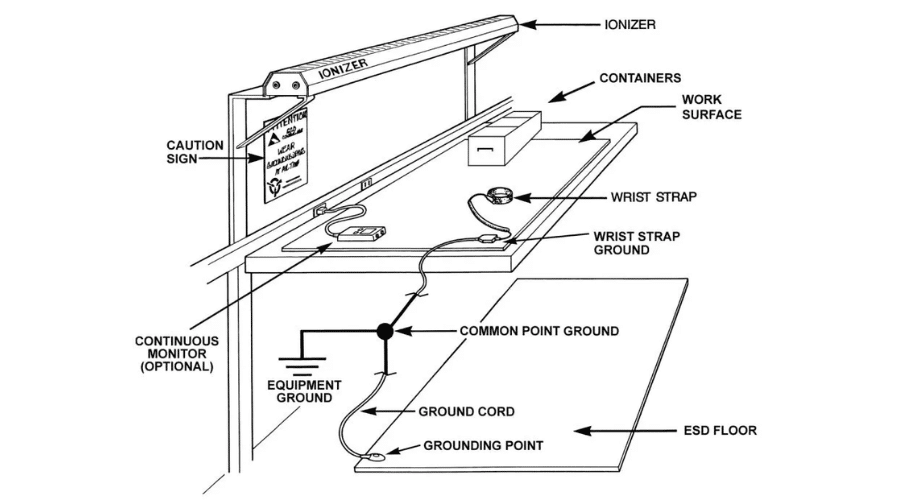
O que é a norma IEC 61340-5-1?
A IEC 61340-5-1 é uma norma internacional emitida pela Comissão Eletrotécnica Internacional (CEI) que diz respeito à proteção de dispositivos electrónicos contra fenómenos electrostáticos. Descreve os requisitos gerais necessários para atenuar os riscos associados às descargas electrostáticas (ESD) que podem danificar componentes e dispositivos electrónicos sensíveis.
Qual é a versão mais recente da norma IEC 61340 5-1?
A versão mais recente da norma IEC 61340-5-1 é IEC 61340-5-1:2024que foi publicada em 21 de maio de 2024. Esta edição é a terceira versão da norma, substituindo a anterior versão de 2016.
É a IEC 61340 5-1 ou a ANSI ESD S20.20?
A norma IEC 61340-5-1, publicada pela Comissão Eletrotécnica Internacional (IEC), é aplicável em ambientes internacionais, particularmente na Europa e noutras regiões que aderem às normas IEC. Define os requisitos para os programas de controlo eletrostático, incluindo a conceção do local de trabalho, a formação do pessoal, os sistemas de ligação à terra e o equipamento de ionização.
Por outro lado, ANSI/ESD S20.20 é uma norma nacional desenvolvida pela Associação ESD nos Estados Unidos. É amplamente aplicada na indústria de fabrico de produtos electrónicos na América do Norte e no mundo, especialmente entre as empresas que fornecem produtos para o mercado dos EUA.
Descobrir principais diferenças entre a norma IEC 61340 5-1 e a norma ANSI ESD S20.20.
Que indústrias necessitam de implementar a norma IEC 61340-5-1?
A norma IEC 61340-5-1 é aplicável principalmente às indústrias que requerem proteção contra descargas electrostáticas (ESD) no manuseamento e produção de Dispositivos electrónicos sensíveis a ESDMais concretamente, inclui os seguintes sectores:
- Indústria eletrónica e eléctrica: Envolve a produção de semicondutores e componentes electrónicos
- Tecnologias da informação e das comunicações: Envolve hardware informático e dispositivos de comunicação
- Indústria automóvel: Contém muitas peças electrónicas, necessitando de controlo estático para segurança.
- Aeroespacial: Requer uma gestão estática rigorosa devido às necessidades de elevada fiabilidade.
- Fabrico de produtos electrónicos de consumo: Inclui produtos como televisores e smartphones
- Fabrico de dispositivos médicos: Os dispositivos são sensíveis a ESD, tornando essencial uma proteção robusta durante a produção.
Quais são os principais requisitos descritos na norma IEC 61340-5-1?
A norma IEC 61340-5-1 define os principais requisitos em dois domínios principais: administrativo e técnico.
Os requisitos administrativos incluem:
- Estabelecimento de um plano de programa de controlo de ESD: As organizações precisam de desenvolver um programa de controlo ESD abrangente para garantir uma proteção eficaz do equipamento eletrónico.
- Formação e Reforço da Consciencialização: É necessária uma formação regular dos trabalhadores para aumentar a sensibilização e melhorar as competências relacionadas com a proteção contra as descargas electrostáticas.
- Qualificação do produto: Conduzir a qualificação dos produtos para garantir que os produtos electrónicos possuem uma imunidade adequada às descargas electrostáticas (ESD).
- Estabelecimento de um plano de verificação da conformidade: Deve ser desenvolvido um plano de verificação da conformidade para validar a eficácia e a aplicação das medidas de controlo de ESD.
Os requisitos técnicos incluem:

- Sistemas de ligação à terra/equipotencial: Devem ser estabelecidos sistemas eficazes de ligação à terra e de ligação equipotencial para evitar a acumulação de cargas estáticas.
- Ligação à terra do pessoal: Devem ser utilizadas técnicas adequadas de ligação à terra estática para o pessoal, de modo a minimizar a acumulação de eletricidade estática durante o trabalho.
- Definição de Áreas de proteção eletrostática (EPAs): Definir claramente os limites das áreas de proteção eletrostática,marcar os dispositivos e ferramentas com o direito Símbolos ESD.
- Embalagem: Devem ser utilizados materiais de embalagem anti-estática adequados para proteger os produtos electrónicos da ESD durante o transporte e o armazenamento.
- Identificação: É necessária uma identificação clara dos equipamentos e áreas de proteção estática para aumentar a visibilidade e a conformidade.
O que está em conformidade com a norma EN 61340-5-1?
Os principais aspectos que estão em conformidade com a norma EN 61340-5-1 incluem: Área Protegida ESD (EPA), Ligação Pessoal à Terra, Produtos de Controlo ESD, Formação e Sensibilização, Monitorização e Manutenção, Documentação e Conformidade, Controlos Ambientais e Procedimentos de Manuseamento.
